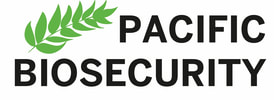|
These are a selection of recent research-related peer-reviewed publications associated with Pacific Biosecurity. Contact us if you would like a personal copy of a publication that you do not have access to.
Gruber MAM, Santoro D, Cooling M, Hoffmann BD, Lester PJ, Boser C & Lach L. 2022. A global review of socioeconomic and environmental impacts of ants reveals new insights for risk assessment. Ecological Applications 32(4), e2577-. https://doi.org/10.1002/eap.2577 Gruber MAM, Janssen May S, Santoro D, Cooling M & Wylie FR. 2021. Predicting socio-economic and biodiversity impacts of invasive species: Red Imported Fire Ant in the developing western Pacific. Ecological Management and Restoration 22(1): 89-99 Vanderwoude C, Boudjelas S, Gruber MAM, Hoffmann BD, Oi DH & Porter SD. 2021. Biosecurity plan for invasive ants in the Pacific Region in Invasive Alien Species Observations and Issues from Around the World. Editors T Pullaiah and MR Ielmini. Wiley International Wittmer HU, Anton V, Gruber MAM, Ireland L, Linklater W, Russell JC, Shannahan DF. 2018. Conservation and restoration in peopled landscapes in Oceania: opportunities and challenges. Pacific Conservation Biology 24:409-416 Gruber MAM, Pierce, RJ, Burne AR, Naseri-Sale L, Lester PJ. 2018. Using community engagement and biodiversity surveys to inform decisions to control invasive species: a case study of yellow crazy ants in Atafu, Tokelau. Pacific Conservation Biology 24:379-387 Gruber MAM, Cooling M & Burne AR. 2017. An invasive ant distribution database to support biosecurity risk analysis in the Pacific. Pacific Conservation Biology 23:258-261 Lester PJ, Gruber MAM. 2016. Booms, busts and population collapses in invasive ants. Biological Invasions 18(11):3091-3101 Gruber MAM, Burne AR, Abbott KL, Pierce RJ, Lester PJ. 2012. Population decline but increased distribution of an invasive ant genotype on a Pacific atoll. Biological Invasions:1-14 |


